Vermes
Advanced Member level 4

The main subject of this article is the battery capacity. Remember that capacity depends on:
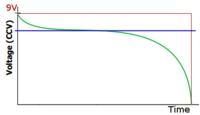
Red – ideal discharge graph
Green – real discharge graph
Blue – an average voltage
The field under the green graph is the capacity → it is an integral from the green graph. A standard way to count the capacity is to measure the voltage in intervals (of course with known load) and count the sum of it (by the load).
On many kinds of batteries we can find one (or both) ways to show the capacity. The capacity is expressed in mAh or W, which is much better.
As it was written before, the capacity depends on various factors, therefore, the term for example 2800mAh tells us it should give for example 280mA for 10h but it's not true – this approach doesn't depend on voltage which is various and it assumes constant current! Please take a look at the graph from Energiser E91.
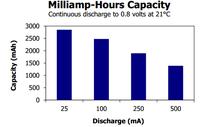
The battery will have 2800mA when the temperature is 21 degrees Celsius and the load is equal 25mA. But, if you will need a 500mA load, the capacity will be equal only 1500mAh. Depending on various load and voltage drop, and of course temperature, self discharge etc., you will never get 2800mAh capacity as it is written on the battery!
Much better situation from that point of view is when the battery capacity is expressed in W. Why? Let us say that battery has a capacity equal 60W what means not less not more that if we need a 12V drop we can get 5A for an hour.
If you want to learn more about the capacity, please read the text below.
All graphs below were taken from an Energiser E91 battery, because it has the best graph suitable for this article. On the end, I'll show you some information about 9V Duracell battery.
Let's start with the temperature affect.
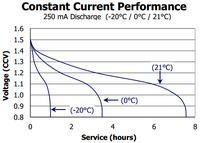
This is a fragment of a battery documentation. As we can see above, the service hours of a battery are strongly related with temperature. The standard working temperature is about 21 degrees Celsius and with a 250mA current discharge it should work for about 8 hours, but when the temperature is about 0 degrees Celsius this time shrinks below 4 hours.
From the above graph, we can read more information. Please take a look at the left voltage axis. If the circuit we designed uses 1.5V, the battery will not last for long. The best cutoff voltage for a alkaline battery is equal about 0.8V (read from the graph above)
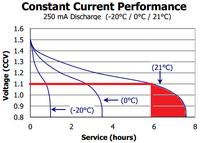
If we create a design which operates on a 1.1V, we will loose the red part of the graph, this capacitance will not be used! Therefore it is very important to set a good voltage drop or use more batteries for more efficient capacity use.
About the 9V battery – for example Energiser 522
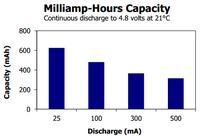
This graph shows the capacity for a 9V Energiser battery. This differs from the earlier drop voltage – here it's 4.8V (it's always about 53.3%). This shows that the capacity of this 9V battery is 600mAh but as it was written before, this statement doesn't mean anything.
The best way to try a battery for you device is to:
- temperature (which affects the internal resistance)
- cutoff voltage
- discharge current
- self discharge (due to the internal resistance)
- the time for which the battery was on the shelf (consequently to the above)

Red – ideal discharge graph
Green – real discharge graph
Blue – an average voltage
The field under the green graph is the capacity → it is an integral from the green graph. A standard way to count the capacity is to measure the voltage in intervals (of course with known load) and count the sum of it (by the load).
On many kinds of batteries we can find one (or both) ways to show the capacity. The capacity is expressed in mAh or W, which is much better.
As it was written before, the capacity depends on various factors, therefore, the term for example 2800mAh tells us it should give for example 280mA for 10h but it's not true – this approach doesn't depend on voltage which is various and it assumes constant current! Please take a look at the graph from Energiser E91.

The battery will have 2800mA when the temperature is 21 degrees Celsius and the load is equal 25mA. But, if you will need a 500mA load, the capacity will be equal only 1500mAh. Depending on various load and voltage drop, and of course temperature, self discharge etc., you will never get 2800mAh capacity as it is written on the battery!
Much better situation from that point of view is when the battery capacity is expressed in W. Why? Let us say that battery has a capacity equal 60W what means not less not more that if we need a 12V drop we can get 5A for an hour.
If you want to learn more about the capacity, please read the text below.
All graphs below were taken from an Energiser E91 battery, because it has the best graph suitable for this article. On the end, I'll show you some information about 9V Duracell battery.
Let's start with the temperature affect.

This is a fragment of a battery documentation. As we can see above, the service hours of a battery are strongly related with temperature. The standard working temperature is about 21 degrees Celsius and with a 250mA current discharge it should work for about 8 hours, but when the temperature is about 0 degrees Celsius this time shrinks below 4 hours.
From the above graph, we can read more information. Please take a look at the left voltage axis. If the circuit we designed uses 1.5V, the battery will not last for long. The best cutoff voltage for a alkaline battery is equal about 0.8V (read from the graph above)

If we create a design which operates on a 1.1V, we will loose the red part of the graph, this capacitance will not be used! Therefore it is very important to set a good voltage drop or use more batteries for more efficient capacity use.
About the 9V battery – for example Energiser 522

This graph shows the capacity for a 9V Energiser battery. This differs from the earlier drop voltage – here it's 4.8V (it's always about 53.3%). This shows that the capacity of this 9V battery is 600mAh but as it was written before, this statement doesn't mean anything.
The best way to try a battery for you device is to:
- examine the temperature in which the device is to work
- examine the voltage drop (if it isn't constant, measure it for a while)
- examine the current (as above, if it isn't constant, measure it for a while)
- look on the date of production of the battery (some batteries have in their documentation a promise, that for example they have 80% capacity after 5 year; all have the shelf file, for example E91 has 10 year in 21 degrees Celsius)
